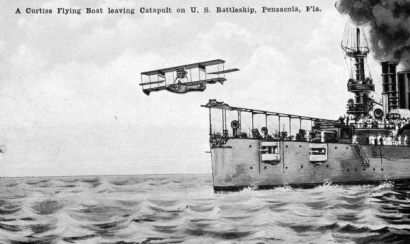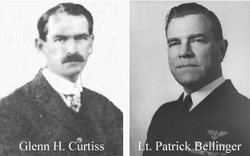April 16, 1915 and 1917 - Aviation takes two steps forward
 Photo: State Archives of Florida, Florida Memory
Photo: State Archives of Florida, Florida Memory
Aviation took two steps forward on this date in 1915 and 1917. In 1915, the first successful catapult launch of an AB-2 "flying boat" took place off the U.S.S. North Carolina in Pensacola. Lt. Patrick Bellinger of the U.S. Navy piloted the aircraft, which was manufactured by the Curtiss Aeroplane Company. Bellinger - who would go on to command all air patrol wings in the Pacific during World War II - was already well-established as a Naval aviation pioneer and hero by this time. He was fourth Naval officer certified as an aviator and the first American to encounter enemy fire in an airplane, flying off the U.S.S. Mississippi during the U.S. occupation of Veracruz in 1914. In 1913, he set an altitude record by flying a Curtiss seaplane at a height of 6,200 feet. Bellinger's successful launch, and others that followed, led to installation of catapult launchers throughout the fleet, and remain common on aircraft carriers today.

Two years later, on this date in 1917, news broke that the Curtiss Exhibition Company purchased 50 acres in the Miami area and planned to establish a permanent aviation school at the site. The expansion would accommodate 200 Army student pilots in addition to the 44 already enrolled and increase the number of training planes from three to 28.
Glenn H. Curtiss, recruited in 1907 by Alexander Graham Bell for Bell's Aerial Experimental Association, formed one of the first aircraft manufacturing companies in 1909 and rapidly expanded, building planes and training pilots for the U.S. and its allies during World War I. In 1920, Curtiss cashed out his stock in the company for $32 million and retired to South Florida, where he developed the cities of Hialeah, Opa-Locka and Miami Springs with rancher James H. Bright.
Glenn H. Curtiss, recruited in 1907 by Alexander Graham Bell for Bell's Aerial Experimental Association, formed one of the first aircraft manufacturing companies in 1909 and rapidly expanded, building planes and training pilots for the U.S. and its allies during World War I. In 1920, Curtiss cashed out his stock in the company for $32 million and retired to South Florida, where he developed the cities of Hialeah, Opa-Locka and Miami Springs with rancher James H. Bright.
Read more about Miami aviation and Glenn Curtiss:
• HistoryMiami's online exhibit Aviation in Miami: The First 100 Years
• Miami Daily News report on expansion of Curtiss aviation school
• Excerpt from The Curtiss-Bright Cities: Hialeah, Miami Springs & Opa Locka by Seth H. Bransom
• HistoryMiami's online exhibit Aviation in Miami: The First 100 Years
• Miami Daily News report on expansion of Curtiss aviation school
• Excerpt from The Curtiss-Bright Cities: Hialeah, Miami Springs & Opa Locka by Seth H. Bransom
